Our next stop was at
Odessa, about as far north as one can get on
the Black Sea. This former and present free port is
connected to Europe by railways and pipelines. It's a huge
manufacturing site and historically Russia's 3rd largest
city. Established as a Russian naval fortress in 1794 by
Catherine the Great, an early wave of Italian
architects gave today's old city a
decidely Italian neo-classical feel.
Primorsky Boulevard
Nowhere is this more evident than on Odessa's grand
pedestrian walkway, the
Primorsky Boulevard which clings to a cliff
parallel to the port where an Ottoman fort once stood.
About 500 yards in length, it is bisected by a grand
stairway capped by a statue of the Duke de Richelieu -- a
French noble who saved Marie Antoinette's life as the mob
stormed Versailles. Fleeing the French storm, he joined the
Russian Army. In 1803 as Odessa was rising, the Tsar
appointed this 36-year-old governor. Eventually he returned
to France -- as Prime Minister, helping to negotiate an
easier settlement post Napoleonic wars for his native
country since he was the Tsar's buddy. This statue was the
first monument in the city to its first hero.
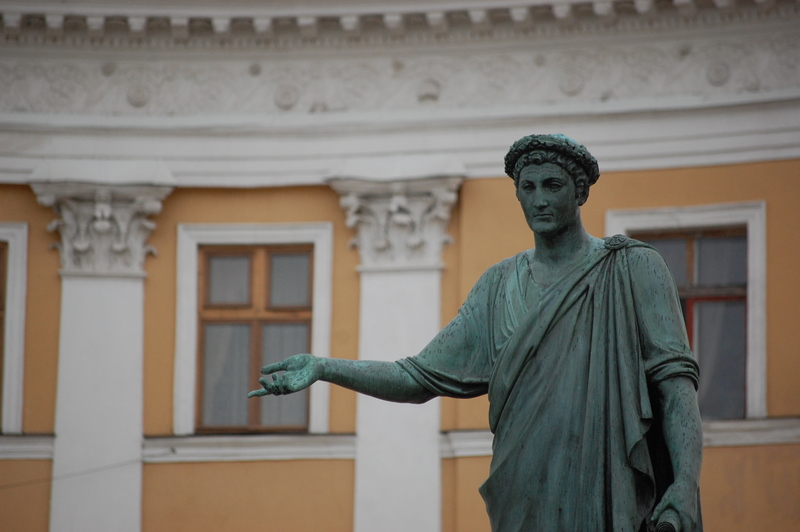
Ivan Martos's bronze of Armand-Emmanuel du Plessis,
duke de Richelieu
The statue sits between two
arc-facaded buildings at the top of the
Odessa steps (often called the Potemkin steps). These were
built around 1830 by the Sardinian Franz Karlowicz Boffo
who designed over 40 buildings in Odessa, including those
at the middle and each end of the
Primorsky Boulevard. He also designed
the empty space which bisects the Boulevard and leads down
to the port.
The Potemkin Steps
Look carefully at the top of the picture below and you will
see the good Duc's statue as well as a few other illusions.
the
Potemkin Steps, so renamed after Sergei
Eisenstein's created one of the most famous scenes of
filmdom in the propaganda classic
The Battleship Potemkin. (
YouTube it by clicking here). Less than 90
feet high, this passageway appears much longer because the
steps are almost twice as wide at the bottom, giving the
impression of parallel lines merging in the distance. The
small statue of the Duc de Richelieu contributes to this
deception. While these appear to be continuous steps, in
fact, there is a landing every 20 steps -- landings which
can't be seen from the bottom of the stairs. From the
top, it's the opposite and viewers see only the steps
immediately in front of them; everything else looks like a
landing. (
Click here for such a view).
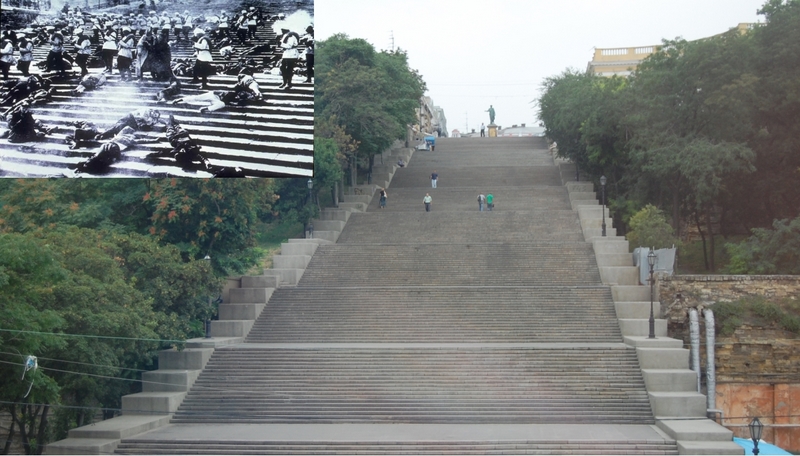
The steps today and
in Eisenstein's The
Battleship Potemkin (inset)
Walking back along Promorsky Boulevard, we straddled lovely
buildings on the
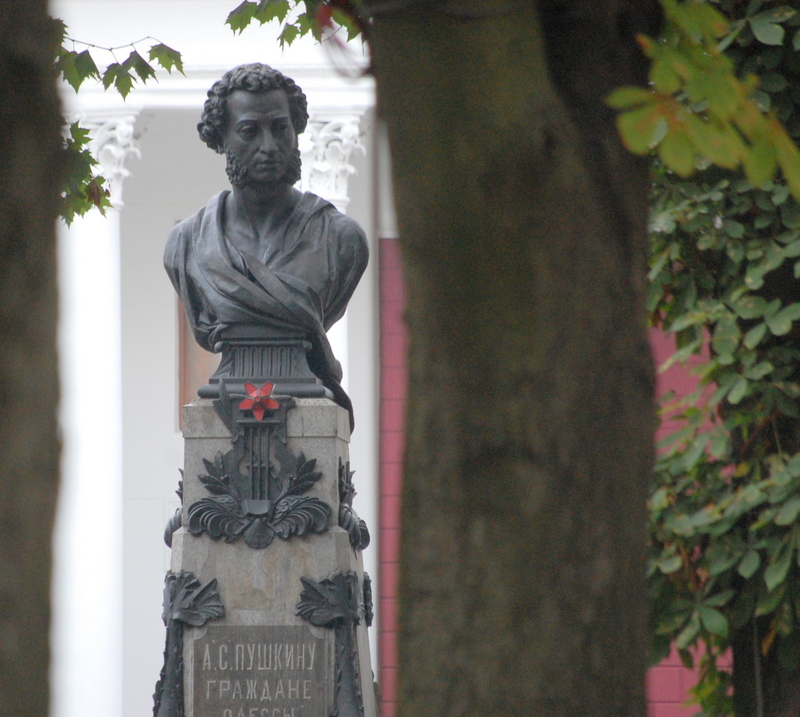
landside and landscaped
gardens on the sea side. At the end of the promenade,
we were greeted by what Odessians feel is the most
realistic statue of Pushkin anywhere. Behind Pushkin
rises Odessa's city hall (once a stock market). Facing him
500 meters at the other end of Promorsky Boulevard is
another Boffo palace, that built for his hated boss (and
husband of his lover Elizabeth), Prince Vorontsov.
City Hall
City Hall (picture below) was once two
two solid rectangles separated by a Corinthian
columned open portico. In the 1870s, Boffo's design was
modified to cover the space in back of the
columns, changing the open space to a grand
entrance.
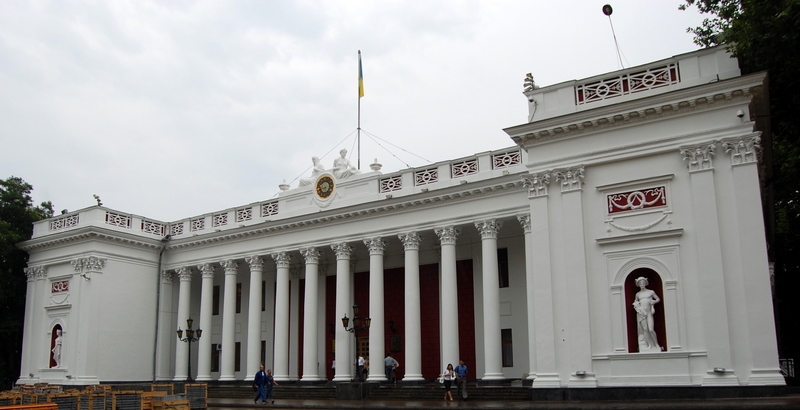
Odessa City Hall
Every half hour, the clock at center top sings out an
operatic love song to Odessa. Marble statues at
top and sides reinforce the building's neo-classical
lines.
Behind city hall stands an earlier neo-classical building
now used as the Archeology museum where we visited some of
the 160,000 exhibits
without getting too excited.
The Odessa Opera
Visible from the port, the Odessa National Academic Theater
of
Opera and Ballet symbolizes the resurgent
Odessa. The opera's 19th century Viennese
baroque/Frech rococo/Italian Renaissance design was by
Viennese architects Ferdinand Fellner and Hermann Helmer
who designed over 20 theaters in their careers.
Restored neoclassic statuary gleams from most niches
and flat roof areas. Air conditioning was provided by
bringing ice to the basement and hoping the cold would
drift up through the vents.
But this now beautifully restored Italian baroque building
quickly fell (actually sunk) on hard times, almost from the
time it was built. After the foundation was laid
in 1884, the building began to sag under its own
weight -- over 6 inches on the east side in the first few
years. Around 1929 a 42-ton firewall was added inside,
causing the inside walls to crack. The root cause of the
problem was that the site occupied a filled-in ravine. Its
weight rested on shifting clay. Luckily the
opera escaped most WWII damage even though Odessa was
heavily bombed by the Germans. The Germans attempted to
destroy the building at their exit by placing explosives in
40 spots inside -- but the quickly advancing Soviet troops
arrived before the Germans could have their way.
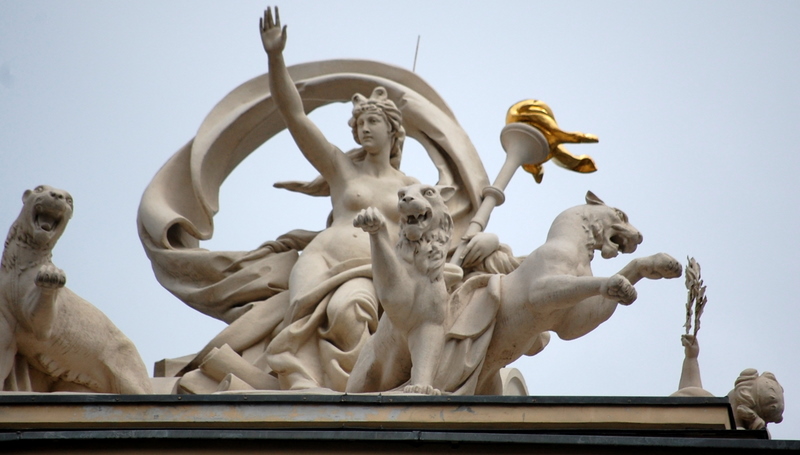
Muse Melpomene, with panthers pulling her chariot,
rides the Odessa Opera House
As the Soviet Union began to implode, money dried up and
already sparse maintenance all but disappeared, causing
even more settling of the building as water began to
accumulate below after every rain. The roof leaked badly as
well. What the Germans were unable to do with dynamite, the
Soviets were doing with time and neglect. Luckily this was
reversed in recent years and today the Odessa Opera (where
Rimsky-Korsakov, Rachmaninoff, and Anna Pavlova
performed amid perfect acoustics) sparkles inside and
out.
Cathedral Square
Next we were off to
Cathedral Square, named after the cathedral
that didn't exist for over 60 years after Joe Stalin
had it dynamited in the middle of the night in 1936.
Post-Soviet Odessa is rebuilding the 19th century building
from the outside in. Below is a somewhat fisheyed
view of this work-in-progress.
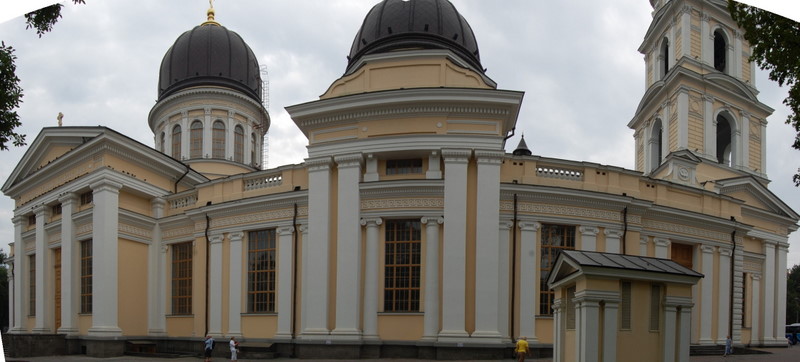
Rebuilding of the Spaso-Preobrazhensky Cathedral
started in 1999.
As you can see, this is pretty much complete on the
exterior. Inside, only the lower level has rooms
which are complete and worship ready.
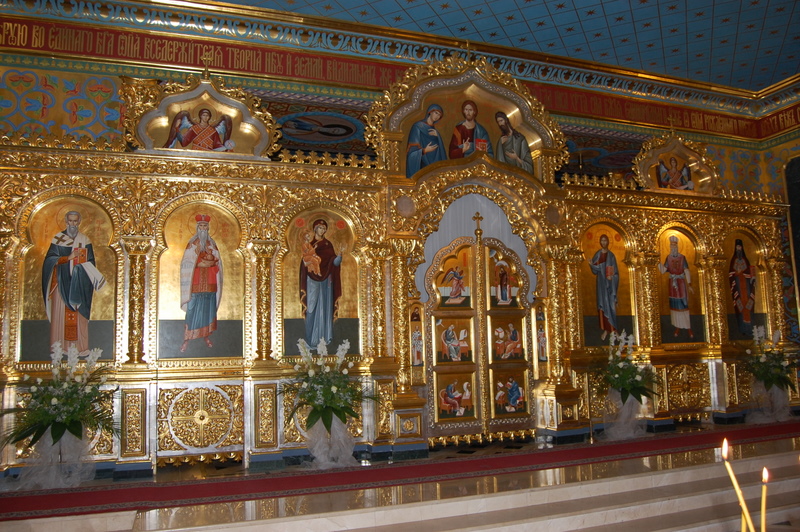
Orthodox icons abound in the lower level of the
Transfiguration Cathedral.
Outside the new cathedral, the square is alive with
Odessians of all ages, riding ponies (real and fake),
taking each other’s pictures with cell phones,
browsing/shopping at the arts fair. Presiding over
all of this is the statue of Prince Count Mikhail S.
Vorontsov, Pushkin's nemesis/victim. He built his mausoleum
in the original cathedral.
Global Tea
We spent the afternoon at a delightful tea hosted by an
extended Ukraine family of two sisters and their daughters
(and a friend) in their early 20's. The young
women were fluent in several languages -- and each was
an only child. Most of them were pursuing graduate degrees
with one about to start working for Morgan Stanley in
London. The new Ukraine appears ready to go
global!

